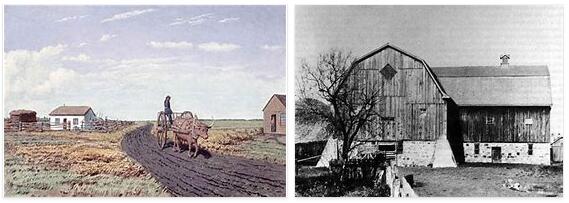NEWFOUNDLAND AND LABRADOR
Newfoundland and Labrador is a Canadian province located in Eastern Canada on the Atlantic Ocean. Important cities include the capital St. John’s
and Gander.
Newfoundland and Labrador have approx. 533,800 residents, and covers 405,212 km².
Labrador is one of the oldest European names in Canada. The region got its name in honor of the Portuguese explorer João Fernandes Lavrador, who together with Pedro de Barcelos saw the country in 1499.
TIMELINE:
1000 – Close to the northernmost point of Newfoundland is L’Anse aux Meadows, where the remains of a Viking settlement (1960) have been found and thus secure evidence of Leif the Happy’s wintering in America around the year 1000. The find and the reconstructed houses attract a significant number of tourists each summer.
1497 – John Cabot arrives in Newfoundland and lands at Bonavista, claiming the land as a British colony.
1583 – The explorer Sir Humphrey Gilbert of England arrives in St. Petersburg. John’s and established a colony.
1774 – The Quebec Act, formerly known as the British North America (Quebec) Act 1774, gives Canada control of Labrador, and thus becomes part of Quebec.
1809 – Labrador Act gives Labrador to Newfoundland.
1846 – A population of 12,000 becomes homeless after a fire breaks out in the grocery store Hamlin’s store on George Street along Water and Duckworth streets, taking away all buildings. The losses included one artilleryman and two civilians. Read here.
1854 – St. John’s was exposed to the cholera epidemic.
1882 – A tornado on Newfoundland destroys 22 ships in Notre Dame Bay.
1914 -The crew of the SS Southern Cross (174 men), did not show up as planned in St. John’s from St. Lawrence (all presumed dead), and two days later a sealer boat, the SS Newfoundland with 89 men, was stranded on ice for 53 hours in an ice storm. A total of 251 died, and this contributed to a change in the seal industry in the future. The government and the public held shipowners and captains more responsible for the safety of the crew. The circumstances surrounding the disappearance of the SS Southern Cross are still unclear.
1929 – On November 18, a tidal wave hits the southwest coast of Newfoundland, killing 27 people.
1933 – Newfoundland runs out of money and the responsible government is forced to resign.
1941 – US troops arrive in St. Petersburg. John’s and began construction at a naval base in Argentia.
1942 – German submarines torpedo the ferry SS Caribou, killing 127 passengers; other German submarines sank ships off Bell Island.
1949 – Newfoundland and Labrador become a province.
1953 – A polio epidemic strikes Newfoundland. See more here.
1985 – The wreckage of the Titanic is found 644 km east of Newfoundland at a depth of just under 4 km.
2010 – Hurricane Igor hits Newfoundland, causing floods, destroying bridges, homes, roads, with damage up to 200 million. dollars.
NEW BRUNSWICK
According to shoppingpicks, New Brunswick is a Canadian province located in Eastern Canada. Important cities include the capitals Fredericton, Moncton and Saint John. The province has both English and French as official languages. The languages are spoken as mother tongues by 64 and 32 percent of the province’s population, respectively.
TIMELINE:
1784 – New Brunswick is established as a British colony and is named after the Duchy of Braunschweig-Lüneburg, from which the then British King, George III, descended.
1922 – The world’s longest covered bridge is built in Hartland. The Hartland Bridge is 391 meters long and crosses the Saint John River from Harland to Somerville.
